
Oops! That page can’t be found.
It looks like nothing was found at this location. Maybe try a search?
NTIA Night Time Economy Summit – E1 London – 9th/10th February 2023
NTIA Announce Second Night Time Economy Summit in conjunction with VibeLab – 9th/10th February
The NTIA & Savenightlife in conjunction with Vibe Lab & Defected are proud to announce the second Night Time Economy Summit in London at the E1 venue in Wapping.
The conference looks to bring together key stakeholders from across the UK and internationally to discuss best practices, historical and present challenges as well as future considerations. The development of new technology around music rights through Pioneer DJ and DJ Monitor, as well as A Greener festival discussing the challenges in meeting net zero by 2030 with small changes making big differences.
Over two days we will see panels and keynotes from UK and international representatives ranging from Police, local authorities, DJs, promoters and many more. The Night Time Economy Conference is the first of its kind in the UK, and brought together over 600 delegates in its first event in Bristol, with over 800 delegates expected in the capital this year.
Some of the Panelists and Speakers for 2023 include..
Harvey Goldsmith CBE / Sacha Lord / Mirik Milan / Claire ONeill / Silvia Montello / Lawrence Barton / Duncan King / Ali Turnham / Philip Kolvin KC / Rob Masterson / Mustard Media / Ben Newby / Mike Grieve / Boyd Sleator / Katy Porter / Lutz Leichsenring / Jeordie Shenton / Sarah Clover / David Lucas / Graeme Park / Wes Sounders / Biff Mitchell / Turno / Chalie Tee / Laidlaw / Mila Falls / Steven Braines / Carly Heath / Yousef / Nikki Mc Neill / Jamie Njoku-Goodwin / Peter Heath / Yuri Doktor / David Boyle / Jon Collins / Dan Davies / Amy Lame / SIA / Home Office / NPCC / Mark Burtonwood / Professor Fiona Measham / Kim Beasley / Christine Osazuwa / Dave Fullerton / Suzanne Bull / Deborah Hewitt / Rick Stainton / Silvana Kill / The Loop / Institute of Licensing / DCMS / Pioneer / Adam Ficek / DJ Monitor / Arts Council / Carl Stevens / PRS Foundation / National Lottery etc
Says NTIA CEO Michael Kill:
“Throughout the pandemic and the current crisis we have grown as a community across the UK, and in 2021 we started a journey to bring the best of our industry together once a year to share our challenges and network amongst our peers.
“An opportunity for operators, regulators, creators, entrepreneurs to come together and share, learn and build a stronger, more resilient industry for the future.”
The two-day event will include over 100 speakers with panels and workshops featuring innovators and entrepreneurs both within the UK and internationally from across the sector.
TRAVELLING TO THE EVENT
Our 2023 Summit will be hosted at the E1 club, in London. Please see their travel advice which covers guidance for tube, bus, car, and other methods of travel:
Travelling by Train
The nearest public transport stations are Shadwell (Overground, DLR), and Wapping (Overground). Shadwell is an 8 minute walk and provides step-free access from the train to the club when arriving with the DLR.
The venue is also a 17-minute walk from Tower Hill station (Circle, District lines) and a 30-minute walk from London Bridge station (Jubilee line, and National Rail).
Travelling by Night buses
The venue is well served by multiple night bus routes, listed below. Click on each one to view the full route on the TfL website.
N551 (Trafalgar Square, City, Poplar, Canning Town)
N253 (Aldgate, Bethnal Green, Hackney, Clapton)
N205 (Paddington, Kings Cross, Shoreditch, Mile End, Stratford)
N25 (Soho, City, Mile End, Bromley by Bow, Ilford)
Parking
Parking is not available outside E1. The nearest car park is Minories Car Park, 1 Shorter Street, E1 8LP . Consult the map below for walking directions from the car park to E1. Please do not park on Pennington Street or Artichoke Hill as you may be clamped.
Taxis
Please see the phone numbers listed below for reputable taxi companies to help plan your journey.
When arriving and leaving, please be quiet and respectful. E1 is in the heart of a residential area and we do not want to disrupt our neighbours.
If arriving or leaving in a taxi, please use the following address:
E1 London, 110 Pennington Street, E1W 2BB
United Cars: 0208 981 9922
GNR Taxi: 0207 739 9522
Whitechapel Cabs: 0207 377 1111
We are also well-served by a range of external taxi firms including Uber, Bolt etc.
Hotels
The nearest hotels are:
Leonardo Royal Hotel, Tower Bridge
Town Hall Hotel, Bethnal Green
Seeing in the Dark – Nighttime’s Potential in Urban Innovation
This is a follow-up to my last blog entry “My personal Night-Shift: Finding Out about the Importance of a Topic“, where I outlined my personal journey towards understanding the significance of the night and culture in urban development.
Introduction: The Night – The Forgotten Time in City Development
I spend most of my working time on projects on sustainable city development. When I bring up the topic of the urban night in this professional context, I often encounter similar reactions: Either a grin or a confused look. A reaction that seems to ask, “this is a fun topic, but what exactly is the connection to what we’re doing here?“. Being in a professional context, I have the impression people want talk about professional topics. And these reactions suggest a perception that the night is not one of them; maybe a topic more for leisure, relaxation or socialising and distinct from ‘serious’ urban issues.1
Much like in my previous blogpost, I want to challenge this notion with a bold claim: What if the after-work hours are precisely when we can best address some of the most pressing urban challenges?2
With insights from my colleagues at Fraunhofer, vibelab, and beyond, I’ve shaped my thoughts around this idea. This blog post will explore those around three core thoughts:
Cosequently, could it be, that the disconnect between after-work life and the sustainable city development agenda is a major factor of what’s slowing our progress towards major urban transitions?6
To tackle the global challenges we face, we need creativity and the cognitive ability to break away from old patterns – qualities that are often more accessible in the after working hours, when we can easier move away from the constraints of formal professional settings2.
The underlying reasons sustainable/green city development and cultural engagement/nightlife aren’t already central to mainstream urban planning are similar: Difficulties in attributing the benefits they provide for society as a whole in economic terms.3 4 5 If the underlying reasons why they are overlooked resemble each other, overlaps should be able to be identified; and consequently ameliorating one sphere could inform and enhance the other simultaneously. Therefore, synergies between the two should exist and could be actively developed and used.
The Night: Why Is It Underrepresented?
The figure below summarises the key points drawn from the publications I read in the process of getting acquainted with the overall topic of nighttime socioeconomics and nighttime ecology. The mentioned arguments made a lasting impression on me and I tried summarising their essence in the following (see footnotes)7.
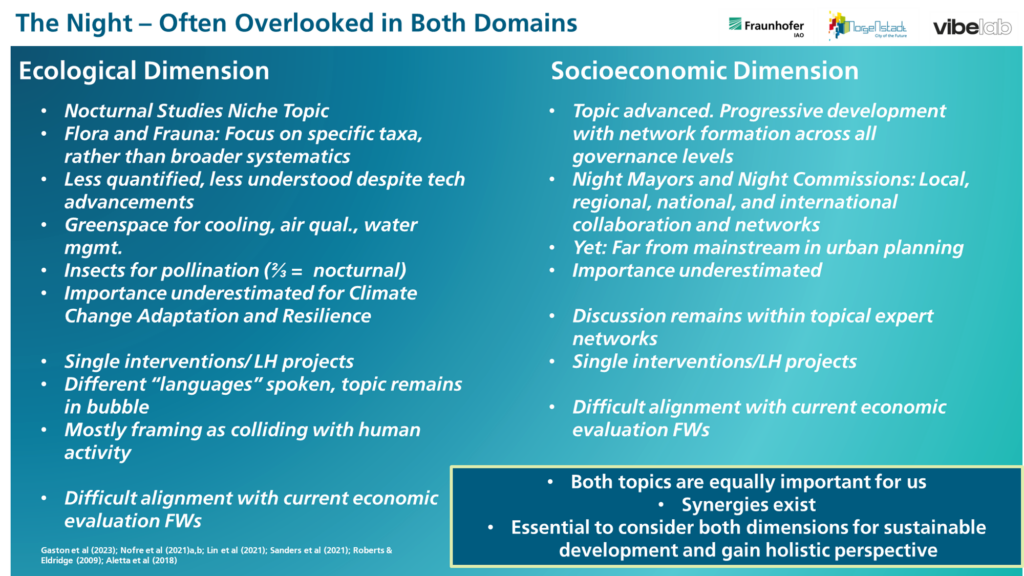
Nocturnal Ecology and Nocturnal Socioeconomics opposed
What literature says:
Societal Perspective1 6 8 9 : What struck me most was a frequently described and seemingly common pattern among urban planners, policymakers, and researchers alike: Most prefer daytime for their professional activities, often neglecting night-time considerations once their workday ends.
Ecological Perspective4 9 10 5 11: Interestingly, to me, most of the key observations in articles from this context could be applied to both ecological and socioeconomic aspects of nighttime. I added the possible relevance for the socioeconomic sector in brackets behind the original arguments I took from my ecological readings:
- Nighttime plays a critical role in ecological balance, analogous to its importance during daytime, yet it remains a niche area of research. (Undoubtly this is true for the societal sphere as well. I’d argue (night-)culture plays a critical role in societal balance. In the societal sphere there is a large advocacy movement on all levels of governance. Yet the topic itself is still far from being part of mainstream city development).
- Its significance is frequently underestimated, leading to its underrepresentation in ecological considerations (…and in urban planning discussions).
- The preference among ecologists to work during daytime contributes to the scarcity of focus on nocturnal studies. (Just like their counterparts in urban planning).
The Challenge with Economics and Economic Metrics
Like in any sector, economic considerations are a driving factor (if not THE driving factor) cities are fundamentally influenced by. Like the economy as a whole, cities aim to create an economically sound and thriving environment for their inhabitants and economic actors. Which itself ultimately underlies all subsequent activities. However, this economic focus often is a difficult fit with both cultural and ecological initiatives. Let me give you two illustrative examples:
Socioeconomic Aspects: Prevailing Informality9
- During almost all of my side gigs while studying and working in hospitality/nightlife, I received my wage payment in cash. These transactions never made it into official economic statistics or tax-related key performance indicators (KPIs). This situation reflects a broader reality: A significant portion of nighttime economy is informally managed, often out of necessity due to stringent regulations. It is therefore not fully represented in financial KPIs of a city. Simply increasing enforcement, such as deploying more tax officers, is not a practical solution.
Ecological Considerations: The Parking Spot Problem10 5 11
- Think about the lifecycle of a typical urban parking spot. Initially, there’s a one-time investment to pave the area. Install a parking meter, and the city enjoys a steady inflow of cash from users. Favourable budgeting no-brainer!
- Now, replace that parking spot with a public garden or a tree. While the initial costs might be similar for removing asphalt and planting, the ongoing expenses for maintenance like gardening and watering present a less appealing economic case under traditional city budgeting models12. Despite numerous studies showing the financial and social benefits of greener urban spaces, widespread adoption remains limited without public intervention.
In a Nutshell: Qualitative Aspects outweigh Monetary Benefits
There’s a reason, why the above mentioned economic metrics are ever so popular: Simplicity. City administrators, planners, politicians, and executives often operate under tight deadlines, needing to make swift but far-reaching decisions. They rely on clear, quantitative data to inform and justify their decisions (in the best case displayed (visually on e.g. dashboards)8).
Integrating new frameworks of calculus, that integrate e.g. the environment5, requires extra effort: Data collection, harmonisation, staff training, IT infrastructure etc. So, why not stick with simpler, straightforward metrics?
But to me, could not the viewpoint and angle be a difficult fit from a start:
What if the non-monetary benefits that both culture and nature bring to urban environments significantly outweigh their economic benefits? Imagine the value of spending time with friends under a leafy tree outside a charming café, or the lasting memories created from a night out at a lively bar or club. How do we quantify these experiences? For those of us reflecting on our youth, how significant are these memories for you?
Yet, either way you turn it: In the real world as of now, there’s no escaping economic metrics. They underlie all subsequent activities. Even if economic benefits are not the target of the things you try to set in motion through cultural and green city development.
But change comes gradually. And we may try being a part of it :)…
The Missing Link
Through my experiences in both sustainability and socioeconomic sectors of city development, including my role at the Nighttime Innovation Network at Fraunhofer since 2022, I have observed a critical gap in how these two spheres intersect and influence city planning. Let me give you my main observations in concise bullet points:
- Large-Scale Integration Lacking – There is a notable absence of a systematic, large-scale linkage between ecological sustainability and the socioeconomic aspects of the after-work time. Each sphere often attempts to address problems related to sustainability based on its own understanding, without substantial cross-disciplinary collaboration. The link yet has to be made in an systematic way on large scale (e.g. in the multilateral sustainable city development my employer Fraunhofer and the Department of Urban Systems Engineering pursues)13.
- Small-Scale Conflict Mediation Dominates – In the realm of nightlife and socioeconomics, the focus often remains on resolving immediate, localised conflicts (e.g., between a bar, a restaurant and its neighbourhood) rather than fostering broader synergies that could benefit the city as a whole. Again, because the link mentioned above is seldom systematically made.
- Focus on Conflict Resolving rather than on Synergies – In the topic, discussions often circulate around human activity and its collision with the needs of ecology. Focussing on the conflicts can lead to a further mismatch between needs of ecology and current urban and economic realities. Finding common ground gets difficult and discussions lengthy. Realigning the focus on the development of synergies could possibly have a greater impact and positive entanglement of societal and ecological advocates. An example here could be the ‘light pollution’ debate 14 , which is one of the center discourses in the field. It is a crucial topic to address. Yet, I think it is a term that inherently suggests conflict rather than cooperation between human needs and environmental considerations15. Put very simply: Nature wants it dark, humans want it illuminated. It requires a lot of negiotiation and education to change this (please see footnotes16 17 18). Also within each sphere the prevailing discourses focus on conflict resolution rather than creation of synergies. 1 9 14
The Benefits – What Do Culture and Ecology Offer, Why Are They Both Vital for Cities?
Both culture and ecology significantly enrich urban life, providing a host of amenities that enhance the liveability and appeal of cities3. These two spheres are fundamental to the attractiveness of urban areas, influencing not only the residents and visitors but also playing a crucial role in where people choose to reside, especially in Western societies.
Fair enough, but here I want to make the bold and (to me) straightforward assumption, that culture and ecology both are at the very core of why some cities continue to thrive while others descend:
What happens if a city is not healthy for its inhabitants or for them to raise their kids? Yes, easy answer: If they can, people will try moving somewhere else.19
What happens if a city is not safe/stable to live in? Yes, easy answer: If they can, People will try moving somewhere else.
What happens if a city is not attractive to live in? Yes, easy answer: If they can, people will try moving somewhere else.19
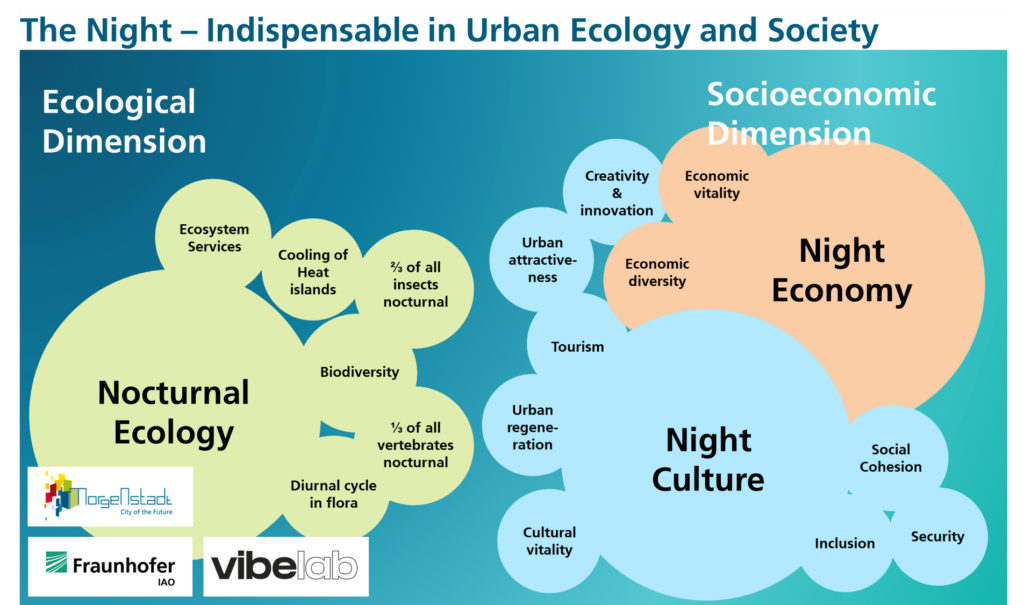
Ecological and Socioeconomic Dimensions of the Urban Night Side-by-Side
For some of the mentioned characteristics both do not only contribute to attractiveness, which is a more or less optional urban development area, but also to vital urban functions3 that are at the core of what a city needs to offer to its citizens: E.g. safety and economic vitality or cooling and water management. Without those, a city will only poorly function.
The Figure above hightlights the individual role of socioeconomics and ecology within the urban system … What could be possible if we try bridging and synergising both?
Finding Ways Forward – Finding the Synergies
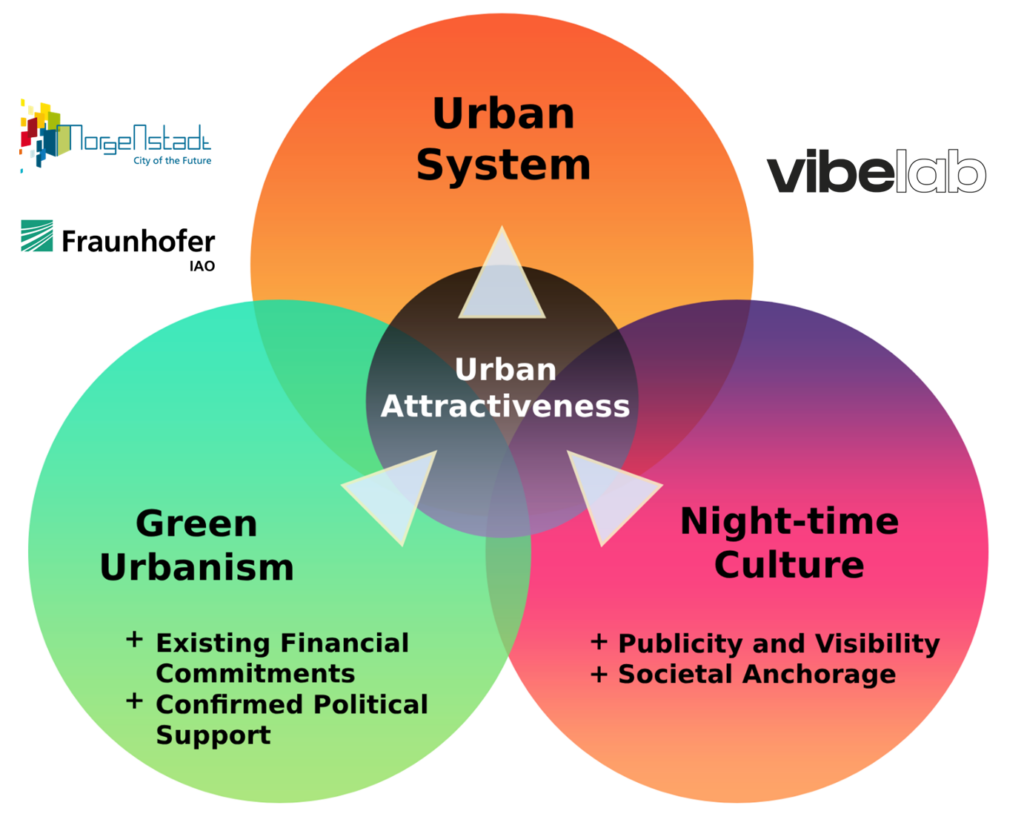
Proposition: Green Urbanism and Night-Culture in Synergy to enhance the Urban System as a whole.
Okay, good we know now…. But what do?!
To me, we should try finding an easy beginning. A beginning where we most likely will face little confrontation but enable those much-spoken synergies in a visible way. The link needs to be easy for everyone to understand the connections and the benefits what thinking about the “other sphere” can provide. Then over time, we may add the more delicate topics that maybe require more discussion and negotiation.
Together with Lutz Leichsenring from Vibelab, I, through my employer Fraunhofer IAO and the Department of Urban Systems Engineering started this process. Among other conferences and thanks to Lutz and Vibelab, I could take part in the ‘South by Southwest Conference and Festival – SXSW’ and the panel “The Transformation of Nightlife for a Sustainable Tomorrow”. This was the onset of our common considerations and since then we meet every couple of weeks to inspire us and to push things forward.
Push Things to Where?!
- One of the easiest links you may find bridging those spheres is Green Soundproofing. I wrote an article on our institute’s blog about this and soon afterwards a couple (!) of German cities reached out and showed their interest. The thought is easy: We spend so much on greening our cities, why not include nighttime culture and get double the benefit?
- And I’d say this is exactly the way to go: Find and make use of the easy links. Make it visible. Make it bold. But above all make it easy to participate.
- Well, listen closely: Coming to your city soon. Vibelab and Fraunhofer will make it happen :)!
… We will provdide a detailed description of our Green Soundproofing concept, the other initiative in the making (“Urban Systems Network Smart City @ Night”) and other practical ideas in the upcoming blogpost. Open-Source and free, just like both night and nature should be :)…
Epilogue: Seeing in the Dark – Nighttime’s Potential in Urban Innovation
Reflecting on why night-time issues remain underrepresented in urban planning reinforces my belief in the need for integrating efforts across both cultural and ecological dimensions. Ultimately, strategies that promote sustainable or green city development can be inherently beneficial for cultural and socioeconomic initiatives and vice versa.
A couple of weeks ago, I watched Jim Jarmusch’s “Night on Earth”, where a taxi driver picks up a blind passenger20. The dialogue goes like this:
Taxi Driver: “It must be really hard to be blind, you’re unable to do so many things.”
Blind Woman: “Listen, jerk, I can do anything you can and a lot of things you’ll never do. I’m blind, that’s all.”
Taxi Driver: “You can’t drive a car, for example.”
Blind Woman: “And you can?”
The joke is, that the driver soon has an accident after this talk.
To me, this dialogue set in motion a stream of thought. I see that this could be understood as metaphor for the topic of this blog post. Urban development has perhaps been ‘blind’ to the full potential night and culture can offer. With the urban re-greening initiatives underway but in a rather ambient pace, also urban development may does not ‘see’ the full beneficial value of re-naturing cities.
Earlier this year, I attended the “Blind Date with Stuttgart” exhibition, an event that transformed participants’ understanding of their environment by navigating a replica of common places in Stuttgart in complete darkness. We were guided by blind individuals. It was unimaginable how difficult I found it to find my way. I and the other participants had to rely on our other senses – feeling, hearing and scenting.
And this is where I see a possible connection to the topic at hand:
City development, to grasp all possible benefits, disbenefits and pathways, requires a full spectrum of senses. Perhaps it’s not about ‘making cities ‘see” the night or about ‘taking cities’ ‘blindness” towards the incredible potential of culture and greening through conventional pathways, by e.g. adapting conventionally used economic metrics, coming up with new KPIs or merging existing ones into more sophisticated units. We tried this with extensive sustainable urban development programmes in the past decades.
Maybe it is more about developing a new ‘sense’ or readjusting towards other, maybe forgotten ‘senses’ for how the urban environment functions around the clock.
Could developing the bespoken synergies be a way? Let us find out. And if you want, let us find out together.
A special thank you to Lutz for revising this text.
… Be in touch: niklas.effenberger@iao.fraunhofer.de
My personal Night-Shift: Finding Out about the Importance of a Topic
This year, I had the opportunity to participate in a panel discussion at the ‘South by Southwest Conference and Festival – SXSW’ titled “The Transformation of Nightlife for a Sustainable Tomorrow” – how exciting!1
But besides this exciting opportunity, besides the fact of being able to travel to Austin, to meeting interesting people and to talking on a panel; over the past years the topic grew closely to my heart.
I genuinely believe, that linking the environmental transition a lot of cities worldwide pursue, with culture and nightlife could benefit both worlds drastically. And guess what – I’m not alone!2
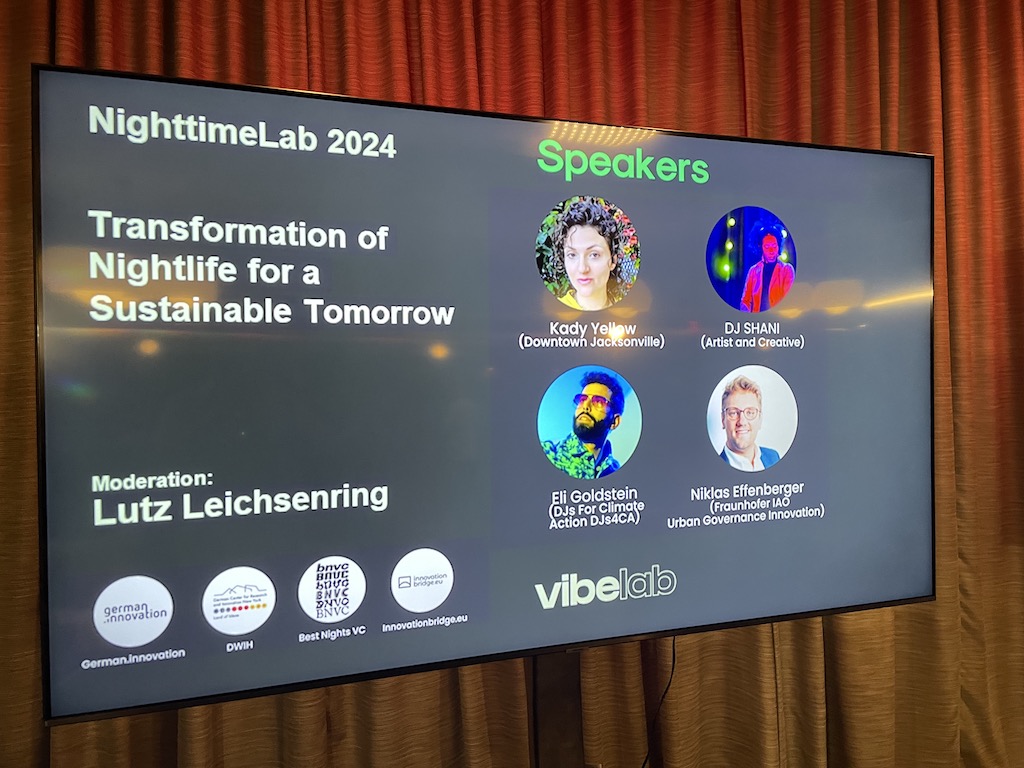
Good panel, good Conference, good mood – let’s go :)!
But let’s go step by step – how did this all start?
Back in the days in 2022, when I started working at Fraunhofer IAO, I took over a project called the Nighttime Innovation Network from my predecessor Jennifer: A series of workshops aimed at resolving conflicts between different interest groups in urban nights. Participants included artists, representatives of nighttime advocacy groups, public authorities (public order office), police, firefighters, security personnel, club and bar owners, and city officials, including Stuttgart’s first Night Mayor.
Due to former engagements as waiter, bartender and kitchen helper several local venues, and due to some of my volunteering activities, I had hands-on experience on how nightculture can look like from both ends. And the issues that may come with it. Now in this workshop, even my city’s first Night Mayor participated. All was pretty exciting for me!
The workshops (all online due to Covid-aftermath) followed a consistent structure: Intro done by Hendrik Meier from Vibelab3 and me, then breakout sessions in different groups, then discussion in big group. Then Hendrik and me synthesising the findings on paper.
Over time and over multiple workshop sessions together we went through identifying overarching themes and subtopics. To then be able to identify related challenges and possible solutions4. This process yielded a long list of possible ways forward, from which we compiled a more general and concise version in the form of policy recommendations. I could present the findings at the about pop conference on night-culture and we received a positive feedback5.
However, one thing stayed with me — during the discussions, also the one during the conference, it was challenging to keep myself and everyone else ‘on track’. We were constantly tempted to switch between different layers of the problem — switching seamlessly talking about individual and specific examples to the ‘bigger picture’ and general implications – back and forth. Localised and individual best-practice examples and overall policy implications were being discussed at the same time. Nevertheless, we managed it and the outcome was useful and well-received! In hindsight this experience proved to be very insightful for me.
The project finished, and sadly, no follow-up funding was secured, so in my working days the Nighttime Innovation Network was naturally replaced with other projects. But I still thought about the topic. I began reading mostly on nocturnal insects and their relationship to light 6 and I could get hold of the newly published book Managing Cities at Night: A Practitioner Guide (see p. 110 for explicit mention and call for action sustainability-nighttime; throughout the book only minor role)7.
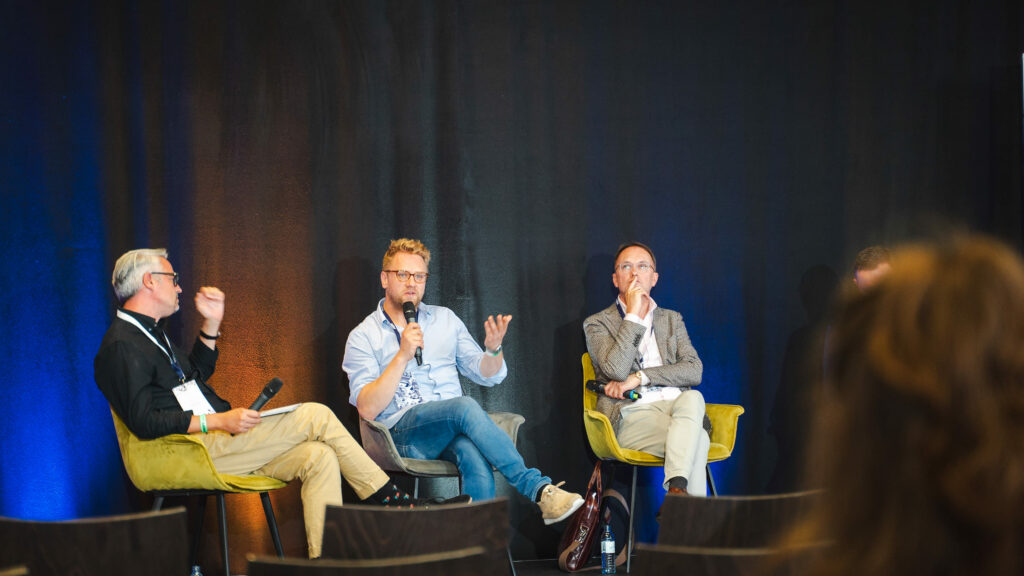
At NOEK conference – talking about how the night is hiding in plain sight
A nocturnal Aha-Moment
It wasn’t until 2023 that I was invited to speak on a panel titled ‘The Night – The Forgotten Time in City Development’ at the NOEK Conference in Mannheim8. Just by reading the title, it clicked. I saw what I did not see before: All the projects I was involved with at Fraunhofer dealt with cities, and all the frameworks and initiatives within them dealt with cities, yet none of them touched on the topic of the night.
My thinking went like this:
- “Aha… day and night are roughly equal in duration, yet our projects primarily focus on daytime…”9
- “Hmmm, but we had the Innovation Network that happened for the night…. Wait a second… funding ran out and everybody went their way. Inside my other projects I am not asked about the topic…
- It came to me that during the Nighttime Innovation Lab, there was the exclusive participation of socioeconomic actors, without the ecological or environmental view present. The topics are covered only in parallel – either the ecological/sustainable city’s perspective or the nocturnal-socioeconomics side..10”
- All the discussions I had with colleagues and friends on the topic came back to me, wow!
- And attending NOEK reinforced my understanding, how common this theme is
Morgenstadt Twilight Innovations – Moving forward and trying to find a way
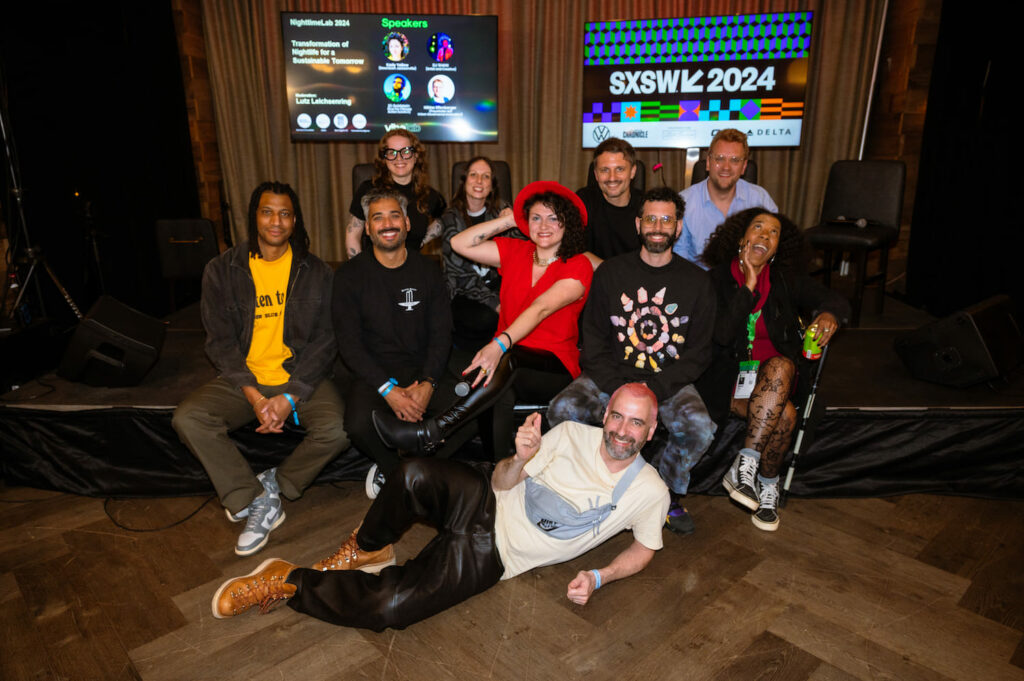
Happy times at SXSW, Photo shot by Andrea Escobar
In the aftermath of this conference I intensified my reading with the texts by Kevin J. Gaston, Vibelab and Jordi Nofre.
And then – it was all magic – I reached out to Lutz and to Jordi, I enthusiastically travelled to SXSW, met many like-minded people, and experienced many new ‘click’ moments. One statement from the panel by Lutz resonated with me: That due to rising temperatures, urban life will likely shift towards the evening and night, making the topic ever more crucial to address.11
I thought to myself: “Well – how more important can it all get?!”
As 2024 goes on, with the help of my supervisors we could set-up a consortium on green soundproofing and start with the development of the ‘Industry Network -Smart City @ Night-‘. Several other ideas are in the pipeline and I’d be so happy to share and possibly get -you, reading this text- on board :).
I will continue with the concepts we came up with in my next blog post – Thanks for reading; btw – this is my first blogpost, yay!
- Thanks to my sponsors allowing me to participate at SXSW – Lutz and Vibelab for the invitation and the ongoing inspiring discussions. And to The German Center for Research and Innovation New York for the financial support. See also description of our panel. ↩
- First and foremost Lutz from Vibelab. As well Jordi Nofre who replied my mails and took time talking to me. Jordi’s research helped me a lot in understanding the topic better. E.g.: “The Urban Ecological Transition and the Future of Europe’s Nightlife Industry” (2023),doi: 10.1080/16078055.2022.2162112; Side note: I couldn’t find Jordi’s Article on Sci-hub.That’s why I reached out to him and that’s why we are in touch until today. Sometimes barriers can create connections :)…. Also Kevin J. Gaston’s work helped me very much, e.g.: “The Nocturnal Problem Revisited” (2019), doi: 10.1086/702250 and “Anthropogenic Changes to the Nighttime Environment” (2023), doi: 10.1093/biosci/biad017; ↩
- Hendrik was Germany’s first publicly elected night-mayor. He was working in the city of Mannheim. A nice place. At the time of the workshop he was affiliated with Vibelab. ↩
- See the slides. ↩
- about pop conference and festival Stuttgart. A special thank-you to Stuttgart’s first night mayor Nils Runge for saving us a spot in the agenda for our discussions. ↩
- See this recent paper: Fabian, S.T., Sondhi, Y., Allen, P.E. et al. Why flying insects gather at artificial light. Nat Commun 15, 689 (2024). https://doi.org/10.1038/s41467-024-44785-3. ↩
- Book, released just in the right time for me: Acuto, Michele, et al. Managing Cities at Night: A Practitioner Guide to the Urban Governance of the Night-Time Economy. 1st ed., Bristol University Press, 2022. JSTOR, https://doi.org/10.2307/j.ctv22jnkcq. (see p. 110 for explicit mention and call for action sustainability-nighttime; throughout the book only minor role) ↩
- By happy coincidence – initially my supervisor was invited to go but hat a conflicting event. Link to NOEK Conference Mannheim. ↩
- Writing this makes me feel kinda silly – this is all so obvious, right?! ↩
- please note: This is simplified and reflecting my personal journey. I am trying to target the bigger picture with my argument and I do not want to discredit initiatives that already move in this and in bridging both worlds. What I personally observed is that in this context, topics related to sustainability are often approached from the cultural/societal sphere’s vision and concept, not as someone from the ecological or city-development sphere might frame them. This goes vice-versa. I vividly remember a discussion between an lighting-experienced ecologist and a cultural/societal night-time advocate, where finding common ground was extremely difficult. ↩
- You can already see this happening in the real world. See an article from September 9, 2023 in the Washington Post – “Extreme heat is forcing America’s farmers to go nocturnal”(paywall). ↩
How can the Creative Footprint help advocates?

“One of the most significant issues is that nightlife advocates often understand things to be true in their practice and experience, but don’t have data to advocate for what they see. Policymakers often want to see evidence-based data, pilots, and so on. Creative Footprint provides the beginning of a baseline. We use scores here, but it’s not necessarily about comparing cities to say that this one is better or worse than that one. It’s more about, OK in 2023, this is the score. Montreal did very strongly on aspects of Community Content and Space. It didn’t do nearly as strongly on what we call Framework Conditions: policies, transit, access to information, governance, and so on. As Montreal puts this nightlife strategy into place for the next years, that section is where the “score” can be increased.”
Diana Raisailles, interviewed by Elsa Fortant
Our team has been in Montreal to launch the latest Creative Footprint Report and for the MTL Night Summit that took place on May 17th and 18th at the PHI Center, bringing together creative minds who wish to learn more about nightlife cultures and the international initiatives that support their development. From tonight to the 21st, NON-STOP 24/24 takes place at Pavillon du Grand Quai of the Port of Montreal.
Montreal Night Summit is a space for learning and outreach!
Montreal is known for its vibrant nightlife, with a bustling scene that attracts locals and tourists alike. The Montreal Night Summit taking place from May 17 to 21, 2023, is an annual event that brings together professionals, policymakers, and nightlife enthusiasts to discuss the challenges and opportunities facing the city’s nightlife scene. This year’s summit theme is NOX ✦ SPATIUM, which explores the possibilities of nightlife beyond just time but also space.
The summit will kick off with a keynote discussion on the Creative Footprint Montreal report from us at VibeLab. The report assesses the city’s cultural and creative ecosystem’s impact and provides a roadmap for a sustainable cultural and creative economy.
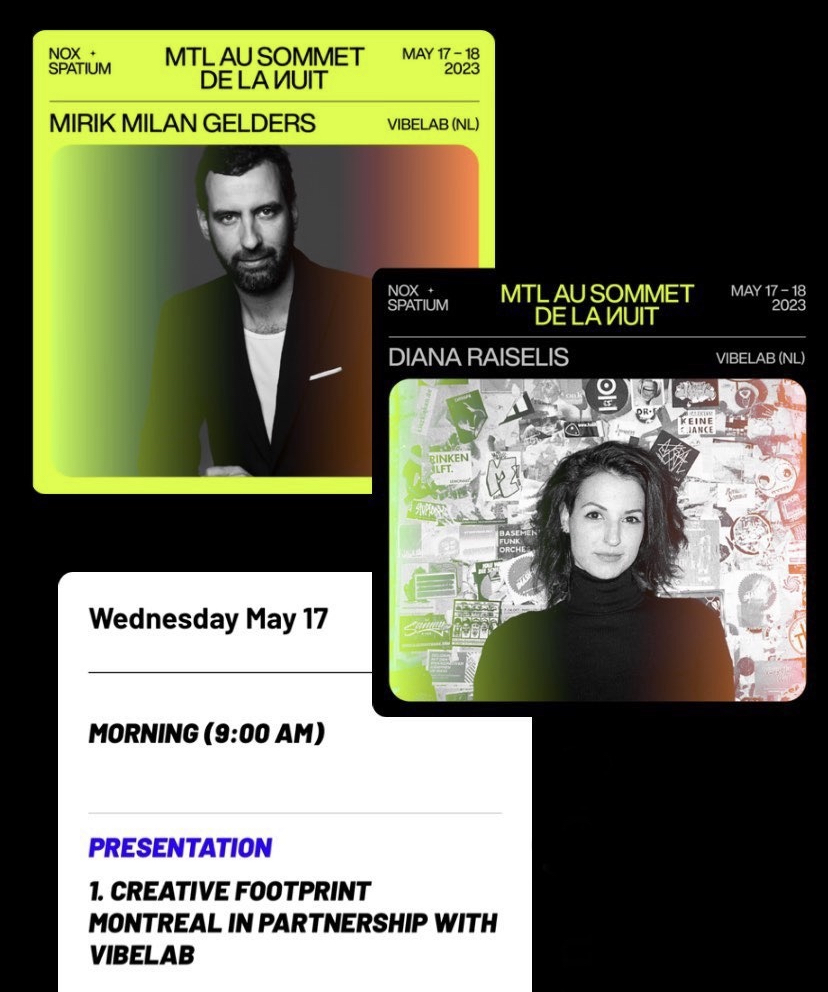
We at VibeLab, will present key research findings and urban policy recommendations from Creative Footprint Montréal — the first comprehensive study of Montréal’s music and nightlife spaces and communities since COVID-19. Conducted in collaboration with PennPraxis, Montréal is the fifth city in the Creative Footprint research project — joining Berlin, New York, Tokyo and Stockholm.
The summit is an opportunity for Montreal to showcase its vibrant and diverse nightlife and its potential to drive economic growth. It is also a chance for policymakers and industry leaders to come together to discuss ways to support the nightlife scene while ensuring public safety and promoting a more harmonious way of living together as citizens.
The Montreal Night Summit is a forum of ideas for nightlife users and professionals as well as for public decision-makers. The event features roundtable discussions with international guests, who share best practices from around the world. These discussions are followed by local perspectives on the challenges and opportunities facing Montreal’s nightlife scene.
The summit is not just a talkfest; it also includes an event promoting Montreal’s nightlife, NON STOP, showcasing local artistic and cultural talent. The event is a celebration of Montreal’s vibrant nightlife and serves as a testing ground for new pilot projects.
The Montreal Night Summit is an essential event for anyone interested in the future of Montreal’s nightlife. It is a space for learning, outreach, and collaboration, bringing together diverse voices to discuss the challenges and opportunities facing the city. Whether you’re a nightlife enthusiast, policymaker, or industry professional, the Montreal Night Summit is not to be missed.
Nashville Independent Venues Study to Host Open House for Community Input on Supporting Local Music Spaces

Metropolitan Nashville Planning Department and the Nashville Independent Venues Study team are inviting locals to participate in their upcoming Open House on May 23, 2023. The Nashville Independent Venues Study aims to better understand the independent music venues ecosystem in Nashville and to aid local government and the community in supporting, preserving, and promoting these important spaces.
The Open House will be an opportunity for participants to discuss the challenges that independent venues in Nashville are facing, as well as to share their experiences and ideas for the future of these spaces and their communities. The event will feature interactive activities, discussions related to venue operations, real estate, funding, and themes related to Nashville’s music culture and ecosystem.
The Open House is a free, drop-in event from 1:00 to 5:00 p.m., and attendees are encouraged to sign up for a specific session to help organizers manage attendance. Light refreshments will be provided.
To access event parking locations, participants can visit this link. The organizers encourage invitees to share the invitation with friends, colleagues, or anyone who may be interested.
If you have any questions, you can direct them to Gabrielle Solair at gabrielle.solair@cultureshiftteam.com. To reach Metro Nashville directly, please contact Special Projects Planner Miranda.Clements@nashville.gov.
PennPraxis, VibeLab & Culture Shift Team warmly welcome all to attend the Open House and contribute their valuable insights and opinions.
More info about the Nashville Independent Venue Study here
How do music genres shape inequalities and spacial dynamics in nightclubs?
Two recent papers by Timo Koren expand on established nighttime research topics of identity formation and regulation, viewing nightlife through the lens of cultural production.
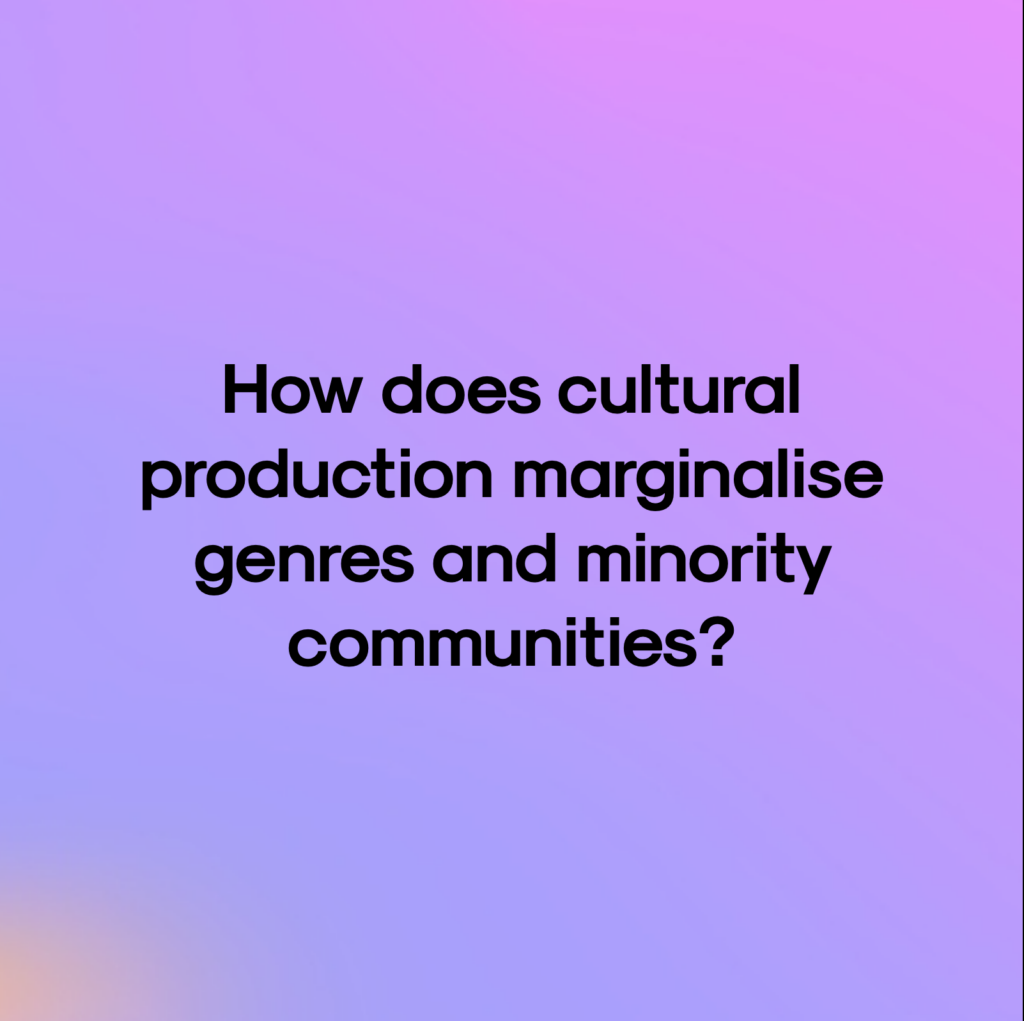
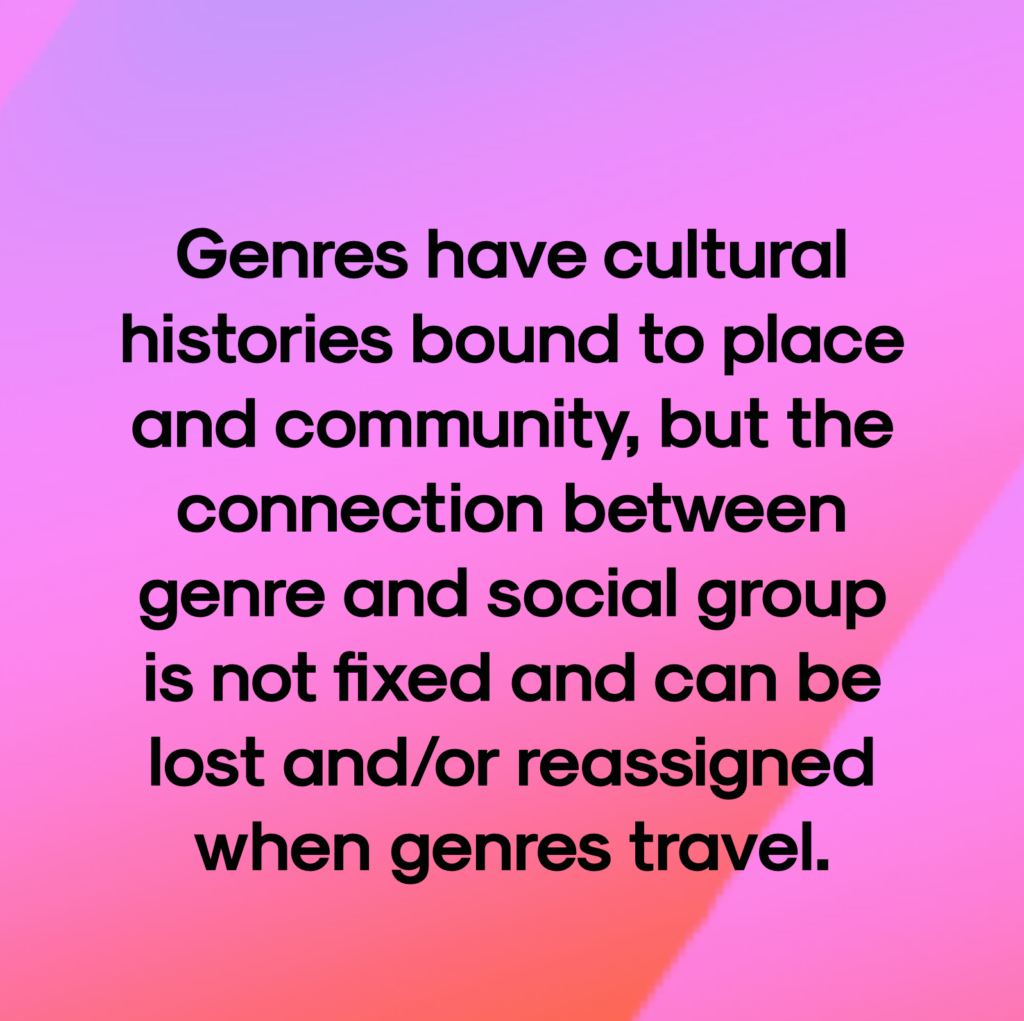
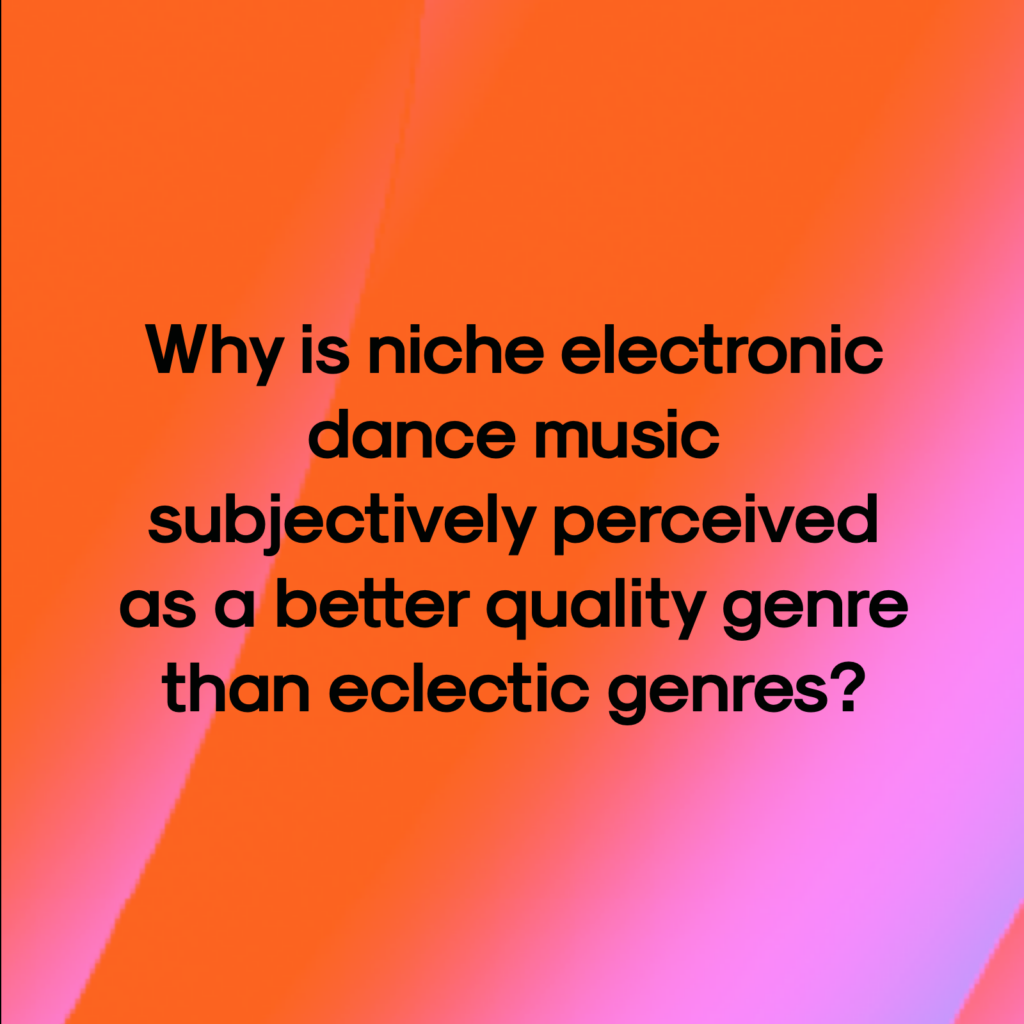
- The research examines how the cultural production and economic organisation of club nights at genre-specific venues impact genres’ gendered meanings and racial inscriptions.
- Gender inequalities in nightlife employment result from informal work cultures’ privileging of male labour, including closed social networks and sexist perceptions and stereotypes within the production of the genre.
- Niche electronic dance music is subjectively perceived as a better quality genre than eclectic genres due to DJ prestige and other factors.
- Niche EDM is associated with masculinity; some eclectic genres, like pop music, are seen as feminine. Genres have cultural histories bound to place and community, but the connection between genre and social group is not fixed and can be lost and/or reassigned when genres travel.
- This research uncovers the importance of programming and promotion in shaping social and spatial conditions in nightlife spaces and nighttime economies.
The Publications:
Koren, T. (2023) ‘ “They were told it was too Black”: The (re)production of whiteness in Amsterdam-based nightclubs’, Geoforum, [link]
Koren, T. (2022) ‘The work that genre does: How music genre mediates gender inequalities in the informal work cultures of Amsterdam’s nightclubs’, Poetics, [link]
Take part in this study on Climate Action in the Electronic Music Industry
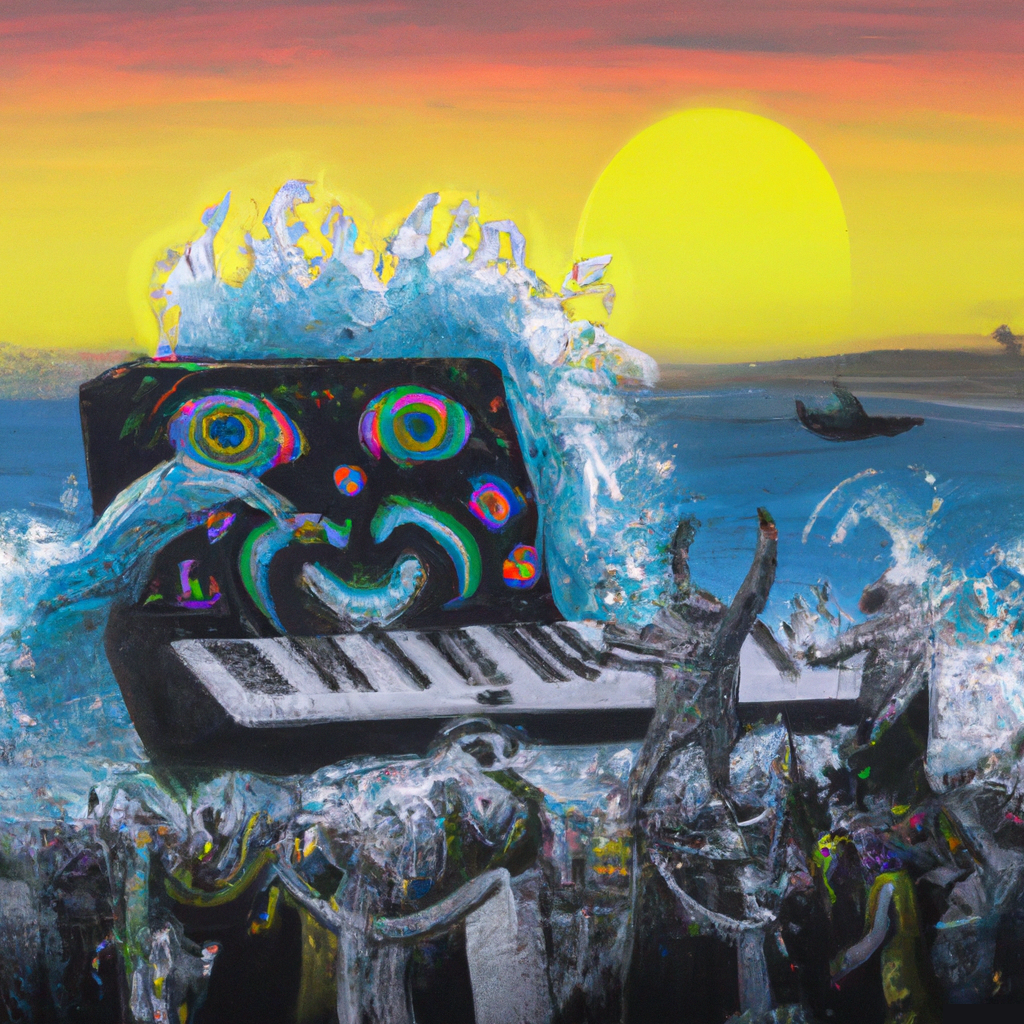
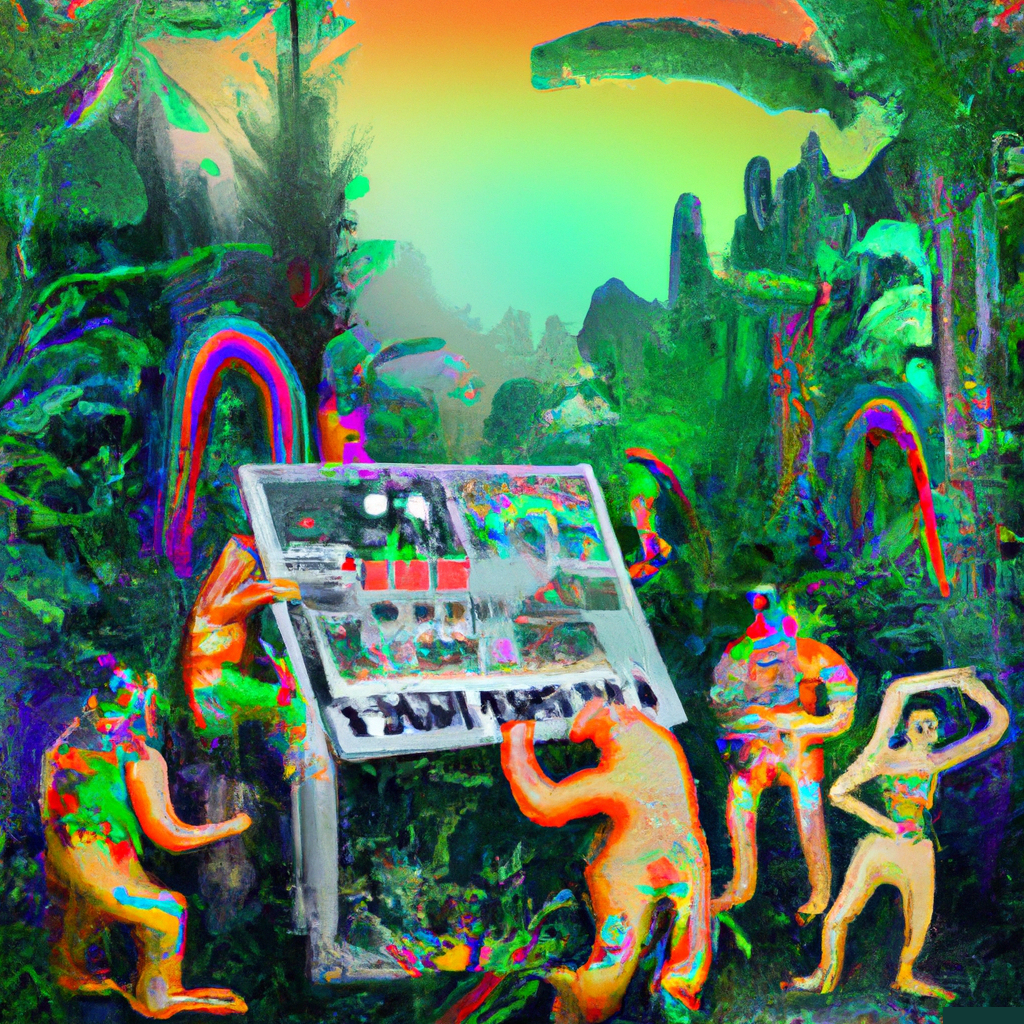
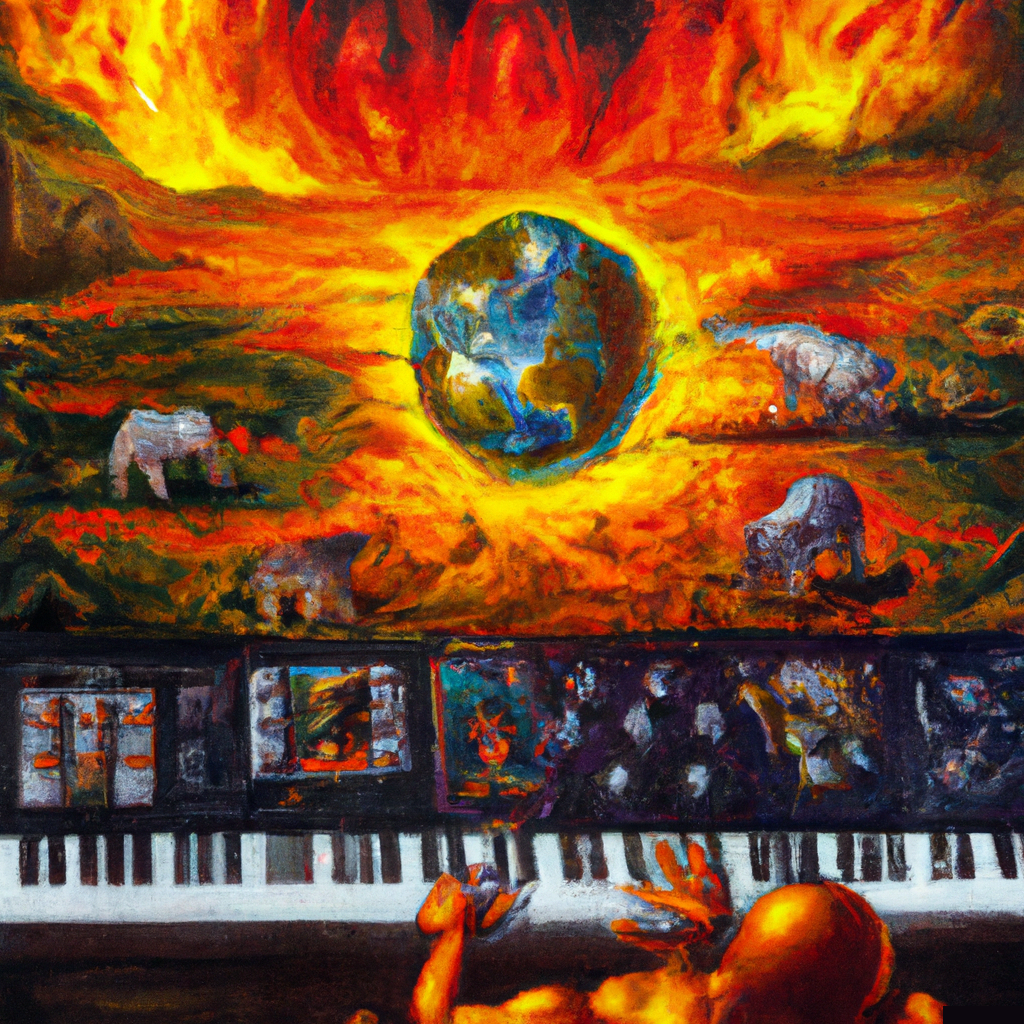
Eli Goldstein, one-half of the DJ duo Soul Clap, requests you to participate in a research study on Climate Action in the Electronic Music Industry. Eli Goldstein is conducting this study at Bard Center for Environmental Policy for a master’s thesis that will be available at Bard College Stevenson Library upon completion in May 2023. The Faculty Advisor for this study is Gautam Sethi, Bard Center for Environmental Policy.
What the study is about?
This is a research study about climate action in the electronic music industry. The purpose of this research is to determine the potential for a voluntary climate agreement in the industry and identify key elements that could be included in an industry-wide voluntary climate agreement. The information gathered from this research will support the development of a framework and roadmap for a voluntary climate agreement in the electronic music industry.
Why you are invited to participate?
You have been invited to participate in this research because you work in or work closely with the electronic music industry.
What does it involve?
You will be asked to read this consent form and acknowledge your consent which takes about 5 minutes. Then you will be asked to complete a survey using Google Forms that will take about 10 minutes. The survey begins with questions about your place in the electronic music industry, feelings about climate change, and participation in climate action. The survey also includes an explanation of voluntary climate agreements and a series of questions that explore your ideas about the potential for a voluntary climate agreement in the electronic music industry.
Any further questions can be emailed to Eli Goldstein at eg7212@bard.edu.
How to address noise complaints and other neighbourhood issues?
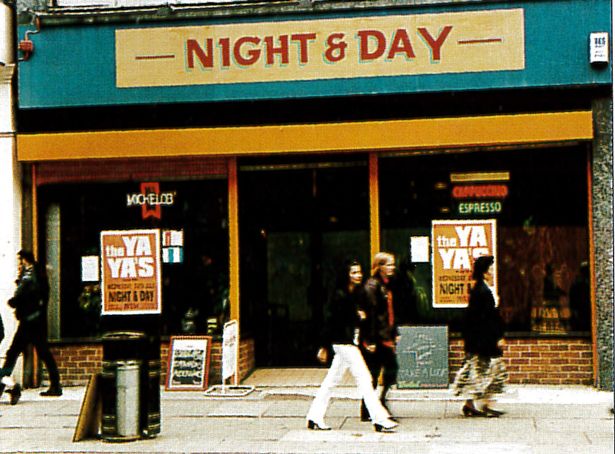
Historical Manchester venue Night & Day 1998
Nightlife scenes and local communities have all the potential to coexist peacefully and productively in the urban environment. Each enriches the other, leading to neighbourhood cohesion, mutual support and social and economic vitality. A city where people, businesses and culture can live, entertain, work and socialise together is a measure of urban economic and social sustainability.
Thriving nightlife districts are those which accommodate and consider residents, as well as invite and attract tourists. Compelling scenes provide platforms for new and innovative artists and maintain ties to neighbourhood traditions. These areas should be safe, functional and fun for all. Urban fabric thrives when urban planning and policy frameworks, zoning regulations and development rules consider residents’ quality of life equal to the commercial and cultural value of nightlife.
Conflicts over the use of urban space:
Unfortunately, conflicts between nightlife spaces, local communities and municipalities do occur. Recurrent quality of life concerns of residents include noise, nuisance and safety. Often, nightlife spaces are attacked by residents and municipalities both for simply providing the entertainment and cultural functions they are meant for. Restrictive curfews, inundation with noise complaints and fines, and unsupervised residential development threaten nightlife spaces and increase tension. Gentrification processes can push out long-standing communities, making way for entertainment districts only accessible to newer, more affluent incoming residents. These same processes can threaten long-standing venues, bars and other nightlife and cultural spaces when new residents do not accept preexisting neighbourhood functions and use. Municipal negligence to these dynamics and runaway real estate development has strained these actors.
When cities do not actively engage with these urban processes, unintended competition and animosity between local residents and businesses can, in the worst cases, lead to venues being forced to shut down under financial burdens. If this trend continues, more and more venues will close, and nightlife districts will lose historic character and vitality. Fortunately, local and international dialogue occurs between nightlife actors and policymakers. Mediation and compromise can be found via both official and unofficial channels. The push for later curfews, and other framework changes, can lead to robust and sustainable nightlife at the same time as livable neighbourhoods.
Agent of change principle:
In many cities, nightlife districts have historically taken root where residential land use is far less common than commercial. Examples include former industrial quarters, river or waterside land and urban core areas that have lost population density due to suburbanisation. This separation of land uses leads to relative peace for nightlife businesses, patrons and local communities. Neither disturbs nor encroaches on the other.
However, as neighbourhoods become increasingly more mixed-use, conflicts arise when existing businesses are burdened with the consequences of incoming residents or vice versa. Noise-generating activities from nightlife, including music and outdoor crowds, may disturb new residents to the degree that official noise complaints are made. Frustrated nightlife businesses are left to contend with resulting fines and a lack of municipal support. One strategy to manage this increasing trend is the agent of change principle.
Essentially, the incoming entity is responsible for mitigating any changes that may occur due to its introduction into a neighbourhood. For example, if a residential apartment block were to be proposed in a nightlife district, the developer must manage the soundproofing of units and other mitigating measures. This would benefit businesses and residents, as neither is forced to deal with a disturbance.
Best practices and priority-setting:
Several nighttime business associations, tourism authorities, different levels of urban to national governments and other nightlife advocacy groups are currently engaging with the topic of “agent of change” and the potential of such measures to mitigate increasing conflicts over noise and nuisance in changing nightlife districts. In this way, best practices and lessons can be shared, leading ideally to the repetition of successes.
In December 2022, representatives from 24 Hour London of the Greater London Authority met with Cansel Kiziltepe, the German Secretary of State, to discuss sustainable 24-hour neighbourhoods where the city centre’s affordable housing construction can coexist with nightlife culture.
The agent of change concept is equally relevant for the construction of affordable housing as for the construction of middle and high-income housing and the conversion of commercial spaces (lofts, etc.) into high-end housing. Led by Night Mayor Robert-Jan Wille, the City of Alkmaar, Netherlands, is conducting location profiling of nightlife businesses, including the quality of soundproofing in nearby residential buildings.
In November 2022, the City of Pittsburgh met with nightlife venues to discuss the agent of change idea and how it can be applied. Also, in the United States, the Nighttime Economy Culture and Policy Alliance (NITE CAP) recently facilitated a gathering of minds on the topic.
In the UK, the Nighttime Industries Association (NTIA) has identified current priorities, including better frameworks for managing noise conflicts, soundproofing and the application of agent of change concepts in the nighttime economy. Nightlife actors understand how essential mitigation is for sustainable nightlife and livable centre city neighbourhoods.
Noise dispute case studies:
More and more venues and nightlife districts come under threat of debilitating fines and
in the worst-case scenario, closure. Complainants are primarily concerned with the noise disturbance from nighttime activities near their residences. Examining a selection of past and present venue case studies illustrates the current state of affairs regarding the agent of change and other creative solutions.
In November 2021, the Manchester Night & Day independent music venue was served with a noise abatement notice from the city council. The venue could be taken to court and closed due to ‘noise nuisance’. The noise complaint originated from a neighbour who had moved in during a pandemic lockdown after the venue reopened. Night & Day opened its stage for emerging artists more than 30 years ago, well before the city council approved the construction of surrounding flats. The venue has already made sound mitigation improvements and meets noise level regulations. They blame the city for not considering existing businesses during housing development and failing to coordinate between municipal departments. Court proceedings will begin in early 2023.
Elsewhere in the UK, Birmingham’s The Nightingale has reached a so-called ‘section 106 agreement’ with developers and the city granting £1.5 million for sound mitigation renovations after a large residential development had been approved ‘in principle’ directly across from the 40-year-old LGBTQIA+ venue. In such agreements, the obligation to lessen community impacts is usually placed on developers. However, in this case, funding for these works has been provided to the venue. On the one hand, the 106 agreement concludes a step forward and an important precedent for defending nightlife districts from new, unregulated residential developments. However, the worry remains because noise complaints can still be filed.
The expenditure by venues in time, legal fees and changes to neighbourhood character still threaten the vitality and survival of nightlife districts. Further examples are seen in the stories of several historical venues in Montreal, all long-standing platforms for emerging artists. Some years ago, Quai des Brumes began receiving noise complaints from a new neighbour who had received permission to convert a commercial space into a residence. The city awarded a subvention to construct sound insulation, which was impossible due to the ageing venue structure. Eventually, Quai des Brumes bought out the neighbour to move. More recently, La Tulipe has also been contending with noise complaints from a neighbour who converted a commercial space next door into a residence. The municipality granted this rezoning permit in error, and the borough government has taken the case to court.
Alternative solutions:
Venues do not stand nor operate alone in these noise and nuisance conflicts. In Manchester, calls for the city council to drop its legal action against Night & Day have come from the city’s music commission and the region’s night-time economy advisor. Close to 100,000 people have signed a petition to drop the abatement notice. City councillors in Birmingham have expressed concern about the impact of new residential development on the longevity of venues such as The Nightingale and the safety of its LGBTQIA+ patrons. Artists who began their careers at such venues, including Matt Healy from The 1975 and Guy Harvey from Elbow (both in the case of Night & Day), have raised their voices against closures.
Attempts are often made to engage directly with surrounding residents in an effort to solve noise conflicts outside of any penal system. Night & Day holds quarterly meetings with local residents to discuss issues of concern. Quai des Brumes and neighbouring venues, including L’Esco and Pow Pow, have called residents directly to discuss noise complaints before they are made to authorities. NTIA encourages members to engage in a ‘360 degree approach’ to communication whereby all businesses, residents and authorities contribute. There is obvious potential for addressing disturbance complaints when the “agent of change” principles are absent or do not apply.
Municipal mediation programs present another option wherein willing participants can problem-solve within their urban communities to avoid costly and unnecessary interference from authorities. The New York City Office of Nightlife has recently launched one such program. MEND (Mediation & Conflict Resolution Program) is a citywide initiative and non-punitive and voluntary mediation program offered to residents and nightlife businesses. MEND is available for disputes between residents and venues, neighbouring venues, and commercial landlords. The program has recently mediated approximately 80 cases with a roughly 80% success rate.
ADE HOT SAUCE COMPETITION ‘22
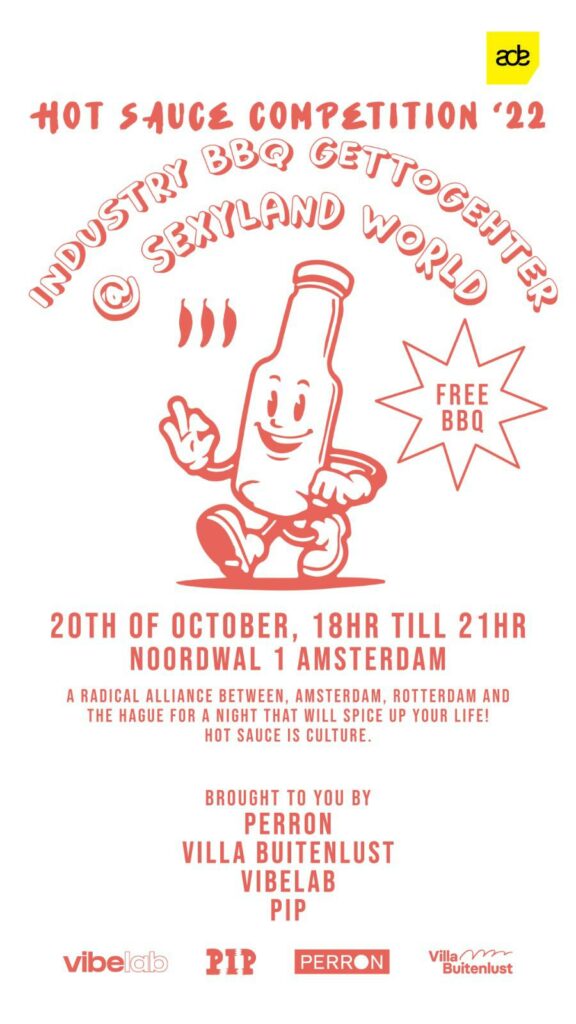
Keeping it spicy this nighttime industry mixer is also a BBQ and a hot sauce competition at SEXYLAND.
Kicking off ADE on Thursday 20th of October, PERRON, Villa Buitenlust, PIP and VibeLab, are bringing the heat with a radical alliance between Amsterdam, Rotterdam and The Hague’s clubbing and cultural scenes,
Nearly every nation has its own cultural rendition of a spicy condiment to enhance the flavour of its food and we want to celebrate this!
Bring along your local hot sauce blend in a jar. It can be homemade, or it can be your favourite local hot sauce from where you live. Enter it into either strand of the competition and enjoy a free BBQ and the chance to meet and share ideas with fellow international dance music lovers
The competition will be judged by:
- Molly: Creator of one of the finest hot sauces we have ever tasted
- Etienne Order: tattoo artist, DJ and brains behind the highly acclaimed ORDER Sichuan restaurant
- A Mystery quest international DJ
The winner of the best hot sauce is awarded a two-night stay at the Villa Buitenlust with late check out for ADE 2023.
Timing:
17:30 The Burn Starts
19:00 The Official Hot Sauce Ceremony
21:00 End of BBQ
Location: Sexyland World, Noordwal 1, Amsterdam
BBQ donations will go towards the Villa Buitenlust’s charity.
Villa Buitenlust is a tranquil retreat, where you can take a step back from life, in the middle of the tranquillity of Westerpark it welcomes people to take a deep breath and reflect. Encouraging cultural integration and focus on mental health support, Villa Buitenlust also hosts artists’ residencies to bring people together. Donations from the BBQ will go towards supporting this project.
Contact info press: Mirik Milan mirik@vibe-lab.org
